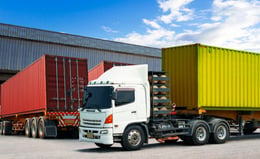Go for the Green: Sustainability in Transportation Management
Nick Ostdick - August 02, 2016

Here’s a staggering statistic: A 2010 report from the U.S. Environmental Protection Agency (EPA) found roughly three-quarters of greenhouse gas emissions in the manufacturing industry originate in the supply chain. That’s about 75 percent. In addition, the report also found an estimated 50 percent of total expenses and greenhouse gas emissions stemmed from the manufacturing supply chain industry, which makes for a great deal of both resource investment and harm to the global environment at the hand of manufacturing and supply companies.
What’s perhaps most startling about this stat is that it’s more than 5 years old and doesn’t take into account the rise in emerging markets and regions in today’s automotive supply stream. In an industry that is increasingly becoming more competitive and crowded, it’s not a far cry to imagine these numbers have, if not worsened, remained consistent during these last five years, and many industry analysts believe the supply chain’s negative impact on the environment will only worsen unless manufacturers and suppliers take significant steps to curb their carbon footprint.
We’ve discussed before on the blog the steps some companies are taking to create a more ‘green’ supply chain, but here’s the bottom line: It’s not enough in today’s supply stream for companies to just effectively manage their supply chain logistics, especially when it comes to transportation management, which arguably has the greatest impact on the natural world. Companies today must also focus on the efficient transportation management strategy while at the same fostering a responsible, eco-friendly platform.
And while that may seem like a zero-sum game in terms of productivity and profitability, sustainability and profitability actually go hand-in-hand. If a company is operating in a more green, sustainable manner, odds are they’re also managing a more lean supply chain - again, specifically on the transportation and freight side of the equation - which can result in enhanced productivity and more cost-effect decision-making.
With all this in mind, let’s look at a few ways planners and managers can introduce sustainable transportation management strategies that will actually help companies meet production and revenue goals while reducing their impact on the global ecosystem.
Consolidating Orders
Consolidating orders and utilizing more flexible shipping and delivery windows will not only help reduce the overall amount of shipments an OEM has to facilitate, but it will also help decrease the amount of movement within the yard or dock which will increase efficiency in dock/yard management and potentially result enhanced productivity at the production site as well. Integrated planning solutions such as BOM management and Every Part Every Interval also function on a level of consolidation in that they reduce the number of moves a manufacturer has to make in order to ensure smooth production programs.
Obviously, the fewer movements of products a company has to engage in the better, and consolidating orders - or even coordinating production programs on corresponding schedules to create greater synchronicity between production and transportation - not only means a reduction in shipments via rail or chassis, but also a decrease in the amount of fuel consumed to make those shipments possible.
Optimizing Load Configurations
It may seem like a small concern, but how products are loaded into a vessel - the order, the layout, etc - has a huge impact on how much product suppliers can ship at any given time. As such, load configurations play a major role in container fill-rates, fuel consumption, rates of emissions, and overall transportation efficiency. Much like the theory of consolidating orders to move the fewest number of shipments possible with the most amount of product, planners and managers must leverage smarter load configuration strategies - and, by association, more intelligent yard and dock management - to experience the greatest ROI and leverage more lean production and supply principles.
In doing so, companies can see significant reductions in their transportation costs, which can free up resources for allocation to different parts along the value chain, making company’s supply chain much more agile and responsive in the face of disruptions or breakdowns.
Utilizing the Data
Without even really knowing it, manufacturers and suppliers more times than not already have massive banks of data at their disposable about how to bent engineer a more green transportation management platform - the trouble is, most companies aren’t acting on that data or even evaluating it in the context of sustainability. In today’s connected, global supply network, most if not all companies are using integrated systems to track freight routes, fuel costs, fill-rates, and other factors that determine a company’s shipping strategy. The next step is to put this data into action to see if order consolidation, optimizing load configurations, or even considering reorganizing how a company works with third-party freight carriers would be advantageous to reducing overall freight costs and enhancing sustainability.
At the end of the day, a large part of reimagining a company’s transportation management platform in a more environmentally conscious manner is less about adopting entirely new strategies and more about making small adjustments to existing operations.
LATEST POSTS
- Understand Circular Economy in The Manufacturing Industry
- How Can Industry 4.0 IT Integration Be Achieved Smoothly?
- The Significance of Order Sequencing in Discrete Manufacturing
- How to improve your Supply Chain Management: The Power of Control Towers
- Optimizing Human Resource Scheduling in Manufacturing: A Technological Approach


